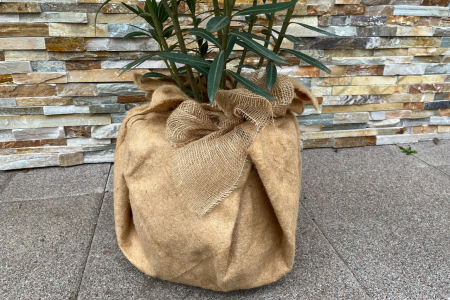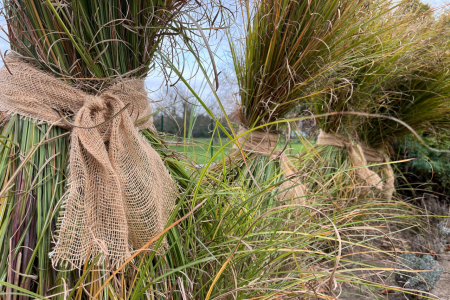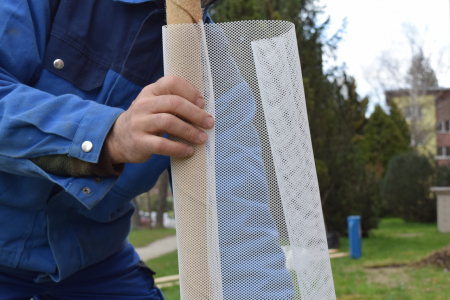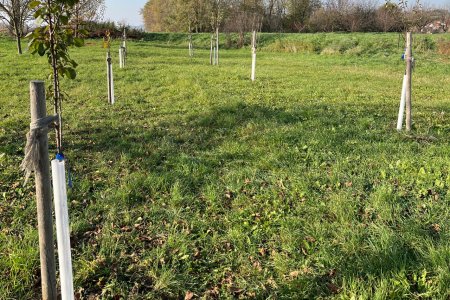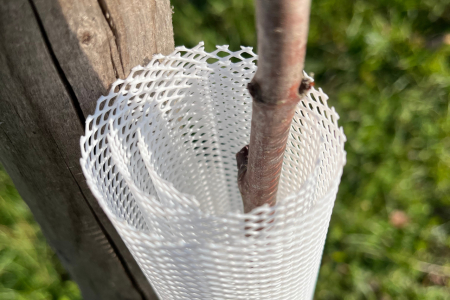
1. Put Heat-Loving Plants in Protective Pots for Winter
If you grow potted plants outside, check if they are frost-resistant. Otherwise, they could freeze. This is especially true for oleanders and geraniums.
Move your heat-loving plants to a winter garden or a cool room. Avoid placing them in a room of temperatures around 22°C, as this can harm the plants. Temperatures of around 5–10°C are ideal for wintering.
If temperatures in your conservatory are just above freezing, provide the plants with extra protection. Wrap their pots in several layers of jute fabric and place a circle of jute felt underneath the pots for better insulation from the floor. To insulate the plant even more, you can also add felt around the pots.
You can also wrap the flower pot with jute felt.
2. Hardly Plants Need Some Winter TLC Too
Do you grow lavender, rhododendrons, heather, and other hardy plants in pots? These can be left outside on your terrace.
That said, it’s still a good idea to wrap the pots in jute fabric or line them with jute felt. Even though the plants are hardy, they’re more vulnerable in pots than in the ground as there’s less soil to insulate them.
Placing the plants in a sunny, sheltered spot away from the wind will also help.
Whether you overwinter the plants on the patio or indoors, remember to water them lightly. They need water even when dormant.
Flower pots lined with jute felt.
3. Use Frost-Proof Covering Fabrics
Unexpected weather changes can catch even the most prepared gardeners off guard. Those sudden spring frosts that weren’t in the forecast can leave you scrambling to protect your plants.
Perhaps you’ve experienced this: one time in spring, you heard on the radio that there might be ground frost in the morning. You realised your plants needed covering but didn’t have any frost-proof fabric at home.
By the time you got to the garden centre the following day, it was all sold out. Others had the same idea and bought it up. Does this sound familiar to you?
This autumn, be smart and get at least one pack of white frost cover fabric. It’s perfect for protecting sensitive plants like strawberries. Orchardists also use it to shield trees in bloom like apricots.
There’s also a thicker beige covering fabric available.
We recommend wrapping the flower pot with jute felt and covering the plant with a beige nonwoven fabric.
4. Tie Up Ornamental Grass
If your garden features clumps of ornamental grass, tie them up for the winter. These plants have delicate roots, and moisture from above could cause them to rot. That's why it’s not recommended to cut the grass in autumn as the longer stems provide natural protection.
Simply tie the grass together with a strip of jute to keep the stems in place and offer extra protection for the roots.
Cut back ornamental grass in spring.
TIP: Make gutter cleaning easier by installing grids. This will prevent leaves from clogging them. Here are more autumn garden maintenance tips.
5. Protect Tree Trunks in Cold Weather
If you have young trees in your garden, it’s a good idea to wrap their trunks with jute cloth.
This helps protect them from excessive drying caused by winter winds.
TIP: Planning to plant new trees before winter? Check out our autumn planting guide.
Rely on Us for Your Garden Textiles and Netting Supply
At Milmar, we specialise in processing both woven and non-woven textiles, as well as netting for home and garden use. We supply these products to distributors and hobby markets in retail-ready packs.
We can manufacture goods tailored to your specific requirements, discussing product dimensions and packaging needs with you. From production to packaging and labelling, everything is handled with your branding.
